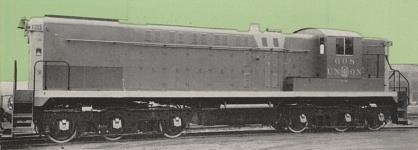Now there is nothing startling or particularly
impressive in these statistics when you lay them
beside those of the nation's great railroads. Never-
the less, the Union is a very busy road. An aver-
age of one train every six minutes passes our
"J" tower. We haul about 70 million revenue
freight tons per year, which is more than many
large trunk lines.
The Union first used diesels eight years ago. At
that time the road bought six 1,000-hp Baldwin

-
One of twelve 1,500-hp, 6-motor diesel-electric road switching
locomotives built by Baldwin for the Union Railroad Company.
DILSEL ENGINE . . . . . . ONE 8-CYLINDER, SUPERCHARGED
MAIN GENERATOR . . . . . . . ONE WESTINGHOUSE TYPE 471
DRIVING MOTORS . . . . . . . . SIX WESTINGHOUSE TYPE 310
WHEELS, DIAM . . . . . . . . . . . . . . . . . . . . . . . . . . . . . . . . . . . . . 47"
WHEEL BASE, EACH TRUCK . . . . . . . . . . . . . . . . . . . . . . . 13' 0"
WHEEL BASE, TOTAL LOCOMOTIVE . . . . . . . . . . . . . . . 44' 6"
WEIGHT IN WORKING ORDER (APPROX.) . . . . . . 325,000 LB.
FUEL OIL CAPACITY . . . . . . . . . . . . . . . . . . . . . . . . . . 1900 GAL.
LUBRICATING OIL CAPACITY . . . . . . . . . . . . . . . . . . 200 GAL.
TRACTIVE EFFORT (30% ADHESION) . . . . . . . . . . . 97,500 LB.
GEAR RATIO . . . . . . . . . . . . . . . . . . . . . . . . . . . . . . . . . . . . . 15:63
CONTINUOUS T. E. RATING . . . . . . . . . . . . . . . . . . . 64,200 LB.
CONTINUOUS RATING SPEED . . . . . . . . . . . . . . . . . . 6.6 MPH.
SAFE SPEED . . . . . . . . . . . . . . . . . . . . . . . . . . . . . . . . . . . 65 MPH.
diesel-electrics which are still in service. The road
proceeded toward dieselization after the war at
a normal speed and for the usual reasons. We
found we were able to operate diesels for about
one-fourth less than the cost of steam locomotives.
We found them more adaptable for our particular
job. We found that the diesels were winning us
good will from those who lived along or near our
right of way. We found that the crew liked the
improved working conditions.
Then a development came which considerably
speeded up our diesel conversion program.
Just before the war, the City of Pittsburgh
passed strict anti-smoke ordinances to affect all
industrial, commercial and domestic users of
solid fuel within its city limits. That program went
into effect shortly after the end of the war, and
the results achieved were so remarkable that all
but a few last-ditch opponents of smoke control
were silenced. Pittsburgh soon lost the pall of
smog that customarily hung over it, and began
to lose its reputation as one of the country's dirt-
iest cities.
In 1947, the Pennsylvania Legislature passed
an enabling act which made it possible for the
Commissioners of Allegheny County to include
that area under smoke control. The commission-
ers appointed a committee to study the problem,
and in due time received a proposed ordinance
from this committee. In May of this year they
passed the ordinance, and Allegheny County
came under smoke control.
The major railroads operating in Allegheny
County, in the meantime, had met with the
County smoke committee last fall, and had agreed
to engage in a voluntary program of smoke con-
trol, looking toward the day when they would
come under enforced county-wide regulations.
We at Union Railroad began a program for even-